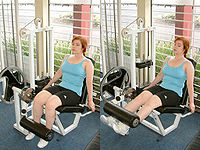
Photo from wikipedia
CONTEXT Deficits in knee extension strength after anterior cruciate ligament reconstruction have been a major problem. The inadequate recovery of the knee extension strength of surgical limb reportedly delays return… Click to show full abstract
CONTEXT Deficits in knee extension strength after anterior cruciate ligament reconstruction have been a major problem. The inadequate recovery of the knee extension strength of surgical limb reportedly delays return to sports and increases reinjury risk. Accordingly, the early detection of knee extension strength deficits after reconstruction may help plan early interventions to manage impairment. This study aimed to clarify the association between knee extension strength at 3 and 6 months after anterior cruciate ligament reconstruction. DESIGN Retrospective study. METHODS Fifty patients who underwent primary anterior cruciate ligament reconstruction using hamstring grafts were included. At 3 months postoperatively, the limb symmetry index (LSI) of isokinetic knee extension strength (IKE) at 60°/s, degree of swelling, passive range of motion of knee flexion and extension, and anterior leg reach distance were measured. At 6 months postoperatively, the LSI of IKE was measured at 60°/s, which was used as the main outcome. A correlation analysis was performed with the LSI of IKE at 6 months postoperatively as the dependent variable and the LSI of IKE at 3 months postoperatively as the independent variable. Subsequently, a multiple regression analysis was performed, with LSI of IKE at 6 months postoperatively as the dependent variable; LSI of IKE at 3 months postoperatively as the independent variable; and other variables, demographic information, and surgical data as covariates. RESULTS The correlation analysis revealed that the LSIs of IKE at 3 and 6 months postoperatively were correlated (r = .535, P < .001). In the multiple regression analysis, the LSI of IKE at 3 months postoperatively was significantly associated with that at 6 months postoperatively, even when other variables were included as covariates (R2 = .349, P = .004). CONCLUSION Asymmetry of knee extension strength at 3 months postoperatively could be more useful than other variables related to knee strength in predicting the asymmetry of knee extension strength at 6 months postoperatively.
Journal Title: Journal of sport rehabilitation
Year Published: 2022
Link to full text (if available)
Share on Social Media: Sign Up to like & get
recommendations!